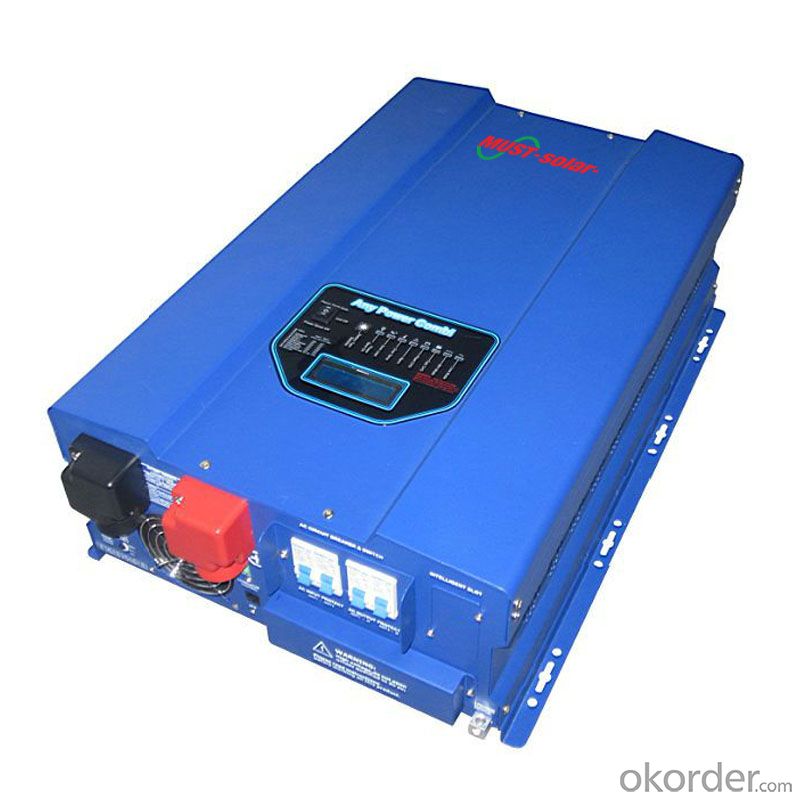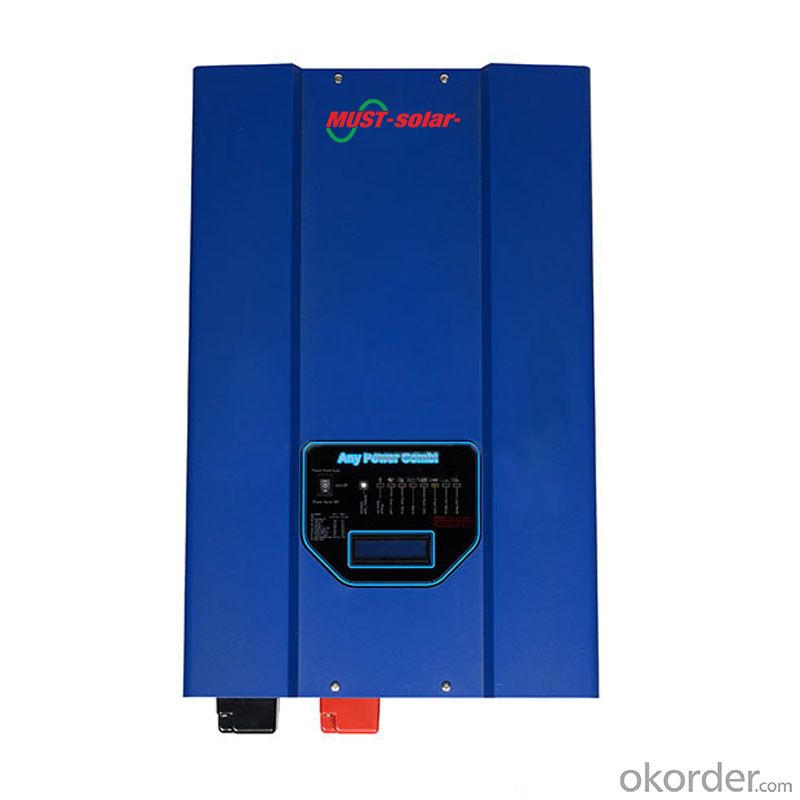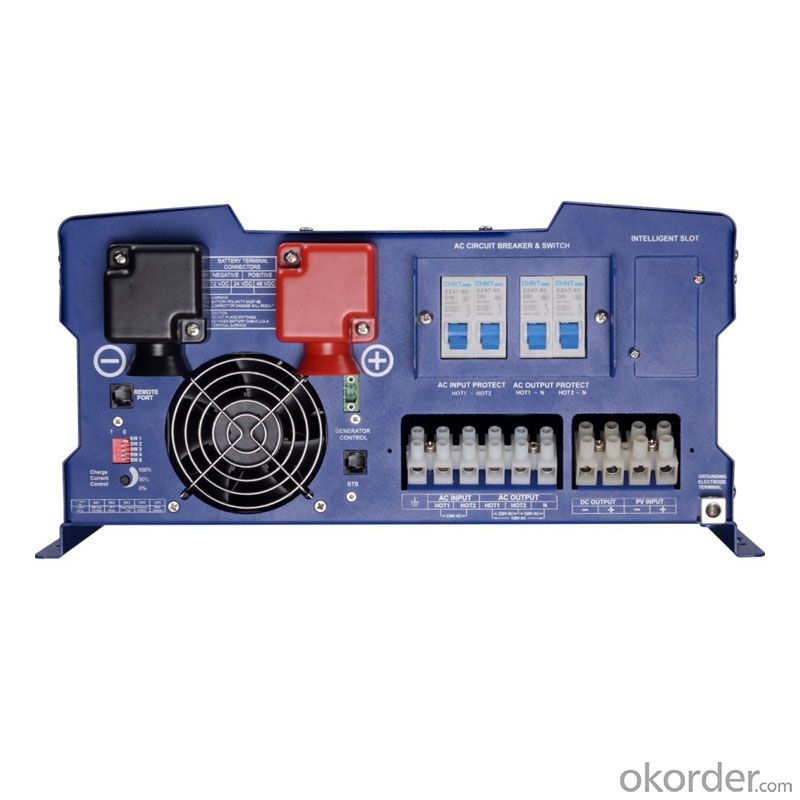Pure Sine Wave Inverter Low Frequency EP3000 Series 8KW-12KW
- Loading Port:
- China main port
- Payment Terms:
- TT OR LC
- Min Order Qty:
- 10 pc
- Supply Capability:
- 1000 pc/month
OKorder Service Pledge
OKorder Financial Service
You Might Also Like
Features:
. Smart Remote Control (RMT)
. Battery Temperature Sensor (BTS)
. Automatic Generator Starting (AGS)
. Support Solar Panel with MPPT Function
. Designed to Operate under Harsh Environment
. DC Start & Automatic Self-Diagnostic Function
. Compatible with Both Linear & Non-Linear Load
. Easy to Install & Easy to Operate & Easy to Solve
| Model | 8.0KW | 10.0KW | 12.0KW | |
| Inverter Output | Continuous Output Power | 8.0KW | 10.0KW | 12.0KW |
| Surge Rating(20ms) | 24.0KW | 30.0KW | 36.0KW | |
| Output Waveform | Pure Sine wave/Same as input(Bypass Mode) | |||
| Nominal Efficiency | >88%(Peak) | |||
| Line Mode Efficiency | >95% | |||
| Power Factor | 0.9-1.0 | |||
| Nominal Output Voltage rms | 100-110-120Vac / 220-230-240Vac | |||
| Output Voltage Regulation | ±10% RMS | |||
| Output Frequency | 50Hz ± 0.3Hz/60Hz ± 0.3Hz | |||
| Short Circuit Protection | Yes( 1sec after fault ) | |||
| Typical transfer Time | 10ms(Max) | |||
| THD | < 10% | |||
| DC Input | Nominal Input Voltage | 12.0Vdc | ||
| ( *2 for 24Vdc, *4 for 48Vdc) | ||||
| Minimum Start Voltage | 10.0Vdc | |||
| Low Battery Alarm | 10.5Vdc / 11.0Vdc | |||
| Low Battery Trip | 10.0Vdc / 10.5Vdc | |||
| High Voltage Alarm | 16.0Vdc | |||
| Low Battery voltage recover | 15.5Vdc | |||
| Idle Consumption-Search Mode | < 25 W when Power Saver On | |||
| Charger | Output Voltage | Depends on battery type | ||
| Charger Breaker Rating | 40A | |||
| Max Charge Power Rate | 1/3 Rating Power | |||
| Battery Initial Voltage for Start Up | 10-15.7V for 12V( *2 for 24V, *4 for 48V) | |||
| Over Charge Protection Shutdown | 15.7V for 12V (*2 for 24V, *4 for 48V) | |||
| Remote Control | Yes(Optional) | |||
| Bypass & Protection | Input Voltage Waveform | Sine wave (Grid or Generator) | ||
| Nominal Voltage | 230Vac | |||
| Max Input AC Voltage | 150VAC For 120Vac LV Mode;300VAC For 230Vac HV Mode; | |||
| Nominal Input Frequency | 50Hz or 60Hz (Auto detect) | |||
| Low Freq Trip | 47±0.3Hz for 50Hz, 57±0.3Hz for 60Hz | |||
| High Freq Trip | 55±0.3Hz for 50Hz, 65±0.3Hz for 60Hz | |||
| Overload protection(SMPS load) | Circuit breaker | |||
| Output Short circuit protection | Circuit breaker | |||
| Bypass breaker rating | 50A | 63A | 63A | |
| Transfer switch rating | 80amp for UL | |||
| Bypass without battery connected | Yes (Optional) | |||
| Max bypass current | 80amp | |||
| Solar Charger (Optional) | Rated Voltage | 12Vdc / 24Vdc / 48Vdc | ||
| Solar Input Voltage Range | 15-30Vdc / 30-55Vdc / 55-100Vdc | |||
| Rated Charge Current | 40 ~ 60A | |||
| Rated Output Current | 15A | |||
| Self Consumption | < 10mA | |||
| Bulk Charge(Default) | *2 for 24Vdc, *4 for 48Vdc | |||
| Floating Charge(Default) | ||||
| Equalization Charge(Default) | ||||
| Over Charge Disconnection | ||||
| Over Charge Recovery | ||||
| Over Discharge Disconnection | ||||
| Over Discharge Reconnection | ||||
| Temperature Compensation | ||||
| Ambient Temperature | 0 ~ 40°C(Full load) 40 ~ 60°C(Derating) | |||
| Mechanical Specifications | Mounting | Wall Mount | ||
| Inverter Dimensions(L*W*H) | 588*415*200mm | |||
| Inverter Weight(Solar Chg)KG | 60+2.5 | 66+2.5 | 70+2.5 | |
| Shipping Dimensions(L*W*H) | 750*520*310mm | |||
| Shipping Weight(Solar Chg)KG | 62+2.5 | 68+2.5 | 72+2.5 | |
| Display | Status LEDs / Status LEDs+LCD | |||
| Standard Warranty | 1 Years (Optional) | |||
Warranty
provides a 1~3 year limited warranty (“Warranty”) against defects in materials and workmanship for its Uninterruptible power supply, Power inverter/chargers, Solar charge controllers, Battery Products (“Product”).
The term of this Warranty begins on the Product(s) initial purchase date, or the date of receipt of the Product(s) by the end user, whichever is later. This must be indicated on the invoice, bill of sale, and/or warranty registration card submitted to MUST-Solar. This Warranty applies to the original MUST-Solar Product purchaser, and is transferable only if the Product remains installed in the original use location.




FAQ
1. How do I decide which system is right for me ?
For protection from long outages, include a generator or solar panels in your Must solar system. Shorter outages can be handled by a battery-only system.
2. Where my system will be installed ?
Must solar systems are usually wall-mounted near a home's main electrical (circuit breaker) panel.
3. How do I install my system ?
A must solar backup inverter is connected to a home electric system , we will supply detailed installation manual and videos for our customers .
- Q:What are the methods of photovoltaic grid-connected inverter control
- and can set the dead time between the upper and lower arms, the use of INTEL 80C196MC to achieve sine wave output circuit, 80C196MC to complete the sine wave signal, AC output voltage, to achieve regulation. Circuit output generally use LC circuit filter high frequency wave, get pure sine wave.
- Q:What is the power factor of a solar inverter?
- The power factor of a solar inverter is a measure of how effectively it converts the DC power generated by solar panels into AC power that can be used by electrical devices. A high power factor indicates efficient conversion, while a low power factor signifies energy losses.
- Q:Can a solar inverter be used with a hybrid solar system?
- Yes, a solar inverter can be used with a hybrid solar system. A hybrid solar system combines both solar power and battery storage, allowing for the utilization of solar energy during the day and stored energy during the night or periods of low sunlight. The solar inverter is responsible for converting the direct current (DC) electricity produced by the solar panels into alternating current (AC) electricity that can be used to power household appliances and be fed into the electrical grid. Therefore, a solar inverter plays a crucial role in ensuring the efficient functioning of a hybrid solar system.
- Q:Can a solar inverter be used in standalone power systems?
- Yes, a solar inverter can be used in standalone power systems. Standalone power systems, also known as off-grid systems, are not connected to the main electricity grid and rely on alternative energy sources like solar panels. A solar inverter converts the direct current (DC) generated by the solar panels into usable alternating current (AC) electricity, which can power various electrical devices in standalone power systems.
- Q:How does a solar inverter handle anti-islanding protection?
- A solar inverter handles anti-islanding protection by continuously monitoring the grid's voltage and frequency. If the grid's voltage or frequency deviates from the predetermined range, indicating a potential islanding condition, the inverter quickly disconnects from the grid to prevent energy flow. This ensures the safety of utility workers and prevents damage to the electrical grid.
- Q:What is the role of Maximum Power Point Tracking (MPPT) in a solar inverter?
- The role of Maximum Power Point Tracking (MPPT) in a solar inverter is to optimize the power output from the solar panels by constantly adjusting the voltage and current to ensure that the solar panels are operating at their maximum power point. This allows the solar inverter to efficiently convert the DC power generated by the solar panels into AC power for use in homes or businesses. By tracking and adjusting the maximum power point, MPPT technology maximizes the overall energy production and improves the overall efficiency of the solar inverter system.
- Q:What is the role of an anti-islanding feature in a solar inverter?
- The role of an anti-islanding feature in a solar inverter is to ensure the safety of utility workers and prevent damage to the electrical grid. It detects when there is a power outage or grid disturbance and immediately shuts off the solar inverter to prevent it from continuing to generate electricity. This feature is crucial as it prevents the solar system from operating independently and feeding power back into the grid, which can be dangerous for utility workers trying to repair the power outage.
- Q:Can a solar inverter be used with different types of communication protocols?
- Yes, a solar inverter can be used with different types of communication protocols. Many modern solar inverters are designed to be compatible with various communication protocols such as Wi-Fi, Ethernet, RS485, and Modbus, among others. This flexibility allows the solar inverter to integrate with different monitoring systems, smart devices, or home automation systems, ensuring seamless communication and control.
- Q:How does a solar inverter handle voltage fluctuations during grid disturbances?
- A solar inverter handles voltage fluctuations during grid disturbances by constantly monitoring the grid voltage. When it detects a fluctuation or disturbance, it adjusts its own output voltage accordingly to stabilize the power supply. This is done through advanced control algorithms that regulate the inverter's power conversion process, ensuring a stable and consistent voltage output despite grid instabilities.
- Q:How does a solar inverter handle harmonics in the grid?
- A solar inverter handles harmonics in the grid by incorporating a built-in filter that helps mitigate the impact of harmonics. This filter is designed to reduce the distortion caused by harmonics, ensuring that the inverter's output adheres to the required grid standards. Additionally, advanced inverters may also employ control algorithms that actively monitor and adjust the output waveform to minimize harmonic distortion and maintain grid stability.
1. Manufacturer Overview |
|
|---|---|
| Location | |
| Year Established | |
| Annual Output Value | |
| Main Markets | |
| Company Certifications | |
2. Manufacturer Certificates |
|
|---|---|
| a) Certification Name | |
| Range | |
| Reference | |
| Validity Period | |
3. Manufacturer Capability |
|
|---|---|
| a)Trade Capacity | |
| Nearest Port | |
| Export Percentage | |
| No.of Employees in Trade Department | |
| Language Spoken: | |
| b)Factory Information | |
| Factory Size: | |
| No. of Production Lines | |
| Contract Manufacturing | |
| Product Price Range | |
Send your message to us
Pure Sine Wave Inverter Low Frequency EP3000 Series 8KW-12KW
- Loading Port:
- China main port
- Payment Terms:
- TT OR LC
- Min Order Qty:
- 10 pc
- Supply Capability:
- 1000 pc/month
OKorder Service Pledge
OKorder Financial Service
Similar products
New products
Hot products
Hot Searches
Related keywords































